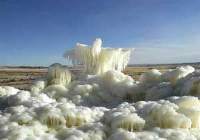What's happening in production
A cool ideaA joint venture between the Gas Technology Institute (GTI) and BC Technologies has achieved commercial operation of its proprietary Freeze-Thaw / Evaporation (FTE) process for produced-water handling. As the name implies, the FTE process involves freezing and thawing produced water to remove dissolved minerals. The process is only applicable in areas that experience seasonal below-freezing temperatures. The technology was previously evaluated by BP in New Mexico’s San Juan basin and by McMurry Oil in the Green River basin of Wyoming. That research was conducted by BC Technologies and the University of North Dakota’s Energy & Environmental Research Center, and cosponsored by GTI and the U.S. Department of Energy. Those demonstrations were sufficient to encourage the joint venture, Crystal Solutions, LLC, to proceed with commercialization. For the past year, Crystal Solutions has been operating its own produced-water treatment facility, which is now operating near capacity. The facility serves operators in the Red Desert / Great Divide basin near Wamsutter, Wyoming. The company also operates a similar facility owned by McMurry Oil.
The simple process involves pumping produced water through a grid of pipes and spray heads onto a large "freezing area." The freeze / thaw and spray cycles result in highly mineralized water – which freezes less readily; it is pumped away for disposal or use. What remains is an ice pile, which eventually melts into relatively pure water that is suitable for many uses (see photo). The greatly reduced volume of brine lowers disposal costs; it could make a loss-to-profit difference in marginally economic wells. The technology also creates a new service for companies that want to outsource management of produced water and can aid in permiting issues. The company is looking for expansion projects. Contact: john.harzu@gastechnology.org. Environment and operations. According to the U.S. DOE, today’s integrated E&P industry will spend as much on environmental compliance as it will on searching for new fields – about $11 billion a year. These costs are magnified relative to the economics of stripper wells, which account for about 25% of onshore, Lower-48 U.S. oil production. In an effort to find ways to continue to protect the environment while reducing operating costs, the DOE is adding seven projects to its research program. The projects range from faster ways to identify historic / cultural sites and subsequent relocation of wells to improvements in oil / produced-water cleanup. Collectively, $4.4 million in federal funding will be combined with $2.3 million in private sector contributions. Online compressors. While the following development is not likely to be the only one of its kind, it is the first such service this editor has encountered. Compressors used in production streams are of such expense and importance that keeping them in good health requires constant monitoring and maintenance. Recent developments in sensor use and bus architecture provide for dozens of sensors that monitor vibration, temperature, pressure and other parameters. Aurion Technologies, Inc., a Dallas-based firm, has commercialized "poll on demand" as part of its WebMonitoring service that allows monitoring of compressors and other equipment via the Internet. Up to 16 data points can be watched by the system and acquired at any time through any type of Internet access, including cell phones and satellite links. In a strategic alliance with Aurion, Gruy Petroleum Management (part of Magnum Hunter Resources) will install 2,000 of the Internet-based monitoring devices on its own facilities, as well as those operated for third parties. Hanover Compressor Co. said it would employ sensors / service on its fleet of compressors. Both Hanover and Gruy have made a minority investment in Aurion. New, different beads. Nalco / Exxon and BP have jointly developed a new water-in-oil dispersion system for controlled release of downhole scale inhibitor. The new delivery system improves squeeze-treatment performance, especially in terms of reservoir wetability. Scale inhibitor is usually an aqueous solution when squeezed. For some wells, this solution does not work and can even be detrimental. Sometimes, the chemicals quickly return to the wellbore. Even worse, the immediate formation can become so water saturated that production is reduced – the opposite of what was intended. The new beads are a liquid-in-liquid encapsulation release system for scale inhibitor. The droplets are extremely small – varying from roughly 0.2 to 2.0 microns. Suspending the chemical in hydrocarbon improves the chances that it will be carried to deeper parts of the reservoir, thus improving contact with producing fluids. Since the treatment can be deployed as a non-aqueous package, it can avoid near-wellbore changes such as trapping water in oil-bearing zones. Also, since oil is lighter than water, it can reduce the possibility of having to swab a well to put it back onstream. A technical paper describing field use will be presented at the SPE
International Symposium in February 2001 in Houston.
|




